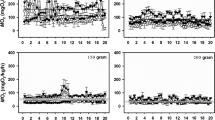Summary
Growth and respiration were measured in a species of Anonchus (Nematoda: Plectidae) at 5°C, 10°C, 15°C, 20°C and 25°C. At 5°C no growth was measurable but the organisms remained active. Maximum production occurred at 15°C, but the highest rate of growth occurred at 20°C. Thus, adult size attained is dependent on the temperature of growth. Respiratory energy losses derived from Cartesian diver microrespirometry, increased with temperature up to 25°C. Regression coefficients (b values) derived from a log log linear regression of weight against oxygen consumption varied between 0.574–1.793, the lowest value being attained at 5°C, the highest at 20°C. Based on Q10, production and respiratory energy losses the optimum temperatures for Anonchus appears to lie between 10°C–15°C.
Similar content being viewed by others
References
Aitkinson, H.J.: The respiratory physiology of nematodes. In: The Organization of Nematodes (N.A. Croll, Ed.) pp. 243–272. New York-London: Academic Press 1976
Andrássy, I.: Die Rauminhalts- und Gewichtsbestimmung der Fadenwürmer (Nematoden). Acta zool. hung. 2, 1–15 (1956)
Block, W., Tilbrook, P.J.: Oxygen uptake in an Antartic collembole Cryptopygus antarticus. Oikos 23, 313–317 (1972)
Brody, S.: Bioenergetics and growth, with special reference to the efficiency complex in domestic animals. New York: Reinhold Publishing Corporation 1945
Bryant, V.: Growth and respiration throughout the life-cycle of Nematospiroides dubius Baylis, 1926 (Nematoda: Heligmosomidae). The free-living stages. Parasitology 67, 245–251 (1973)
Bryant, V., Laybourn, J.: The vertical distribution of Ciliophora and Nematoda in the sediments of Loch Leven, Kinross. Proc. R.S.E. (B) 74 (17), 265–273 (1972/73)
Duncan, A., Schiemer, F., Klekowski, R.Z.: A preliminary study of feeding rates on bacterial food by adult females of a benthic nematode Plectus palustris de Man 1880. Pol. Arch. Hydrobiol. 21, 249–258 (1974)
Klekowski, R.Z.: Cartesian diver microrespirometry for aquatic animals. Pol. Arch. Hydrobiol. 18, 93–114 (1971)
Klekowski, R.Z., Wasilewska, L., Paplińska, E.: Oxygen consumption in the developmental stages of Panagrolaimus rigidus. Nematologica 20, 61–68 (1974)
Lawton, J.H.: Ecological energetics studies on larvae of the damselfly Pyrrhosoma nymphula (Sulzer) (Odonata: Zygoptera). J. Anim. Ecol. 40, 385–423 (1971)
Laybourn, J.: Respiratory energy losses in Stentor coeruleus Ehrenberg (Ciliophora). Oecologia (Berl.) 21, 273–278 (1975)
Laybourn, J., Finlay, B.J.: Respiratory energy losses related to cell weight and temperature in ciliated Protozoa. Oecologia (Berl.) 24, 349–356 (1976)
Marchant, R., Nicholas, W.L.: An energy budget for the free-living nematode Pelodera (Rhabditidae). Oecologia (Berl.) 16, 237–252 (1974)
McFarlane, A., McLusky, D.S.: The oxygen consumption of chironomid larvae from Loch Leven, in relation to temperature. Comp. Biochem. Physiol., A, 43, 991–1002 (1972)
McLaren, J.A.: Some relationships between temperature and egg size, body size, development rate and fecundity of the copepod Pseudocalanus. Limnol. Oceangr. 10, 528–538 (1965)
Myers, R.F.: Osmoregulation in Panagrellus redivivus and Aphelenchus avenae. Nematologica 12, 579–586 (1967)
Nielsen, C.O.: Studies on soil microfauna. II. The soil inhabiting nematodes. Nat. Jutl. 2, 1–31 (1949)
Phillipson, J.: The ‘best estimate’ of respiratory metabolism: its applicability to field situations. Pol. Arch. Hydrobiol. 17, 31–41 (1970)
Phillipson, J., Abel, R., Steel, J., Woodell, S.R.J.: Nematode numbers, biomass and respiratory metabolism in a beech woodland — Wytham Woods, Oxford. Oecologia (Berl.) 27, 141–155 (1977)
Prejs, K.: Some problems of the ecology of benthic nematodes (Nematoda) of Mikolajskie Lake. Ekol. Pol., A, 18, 225–242 (1970)
Soyza, K. de: Energetics of Aphelenchus avenae in monoxenic culture. Proc. Helminth. Soc. Wash. 40, 1–10 (1973)
Wieser, W.: Temperature relations of ectotherms. A speculative review. In: Effects of temperature on extothermic organisms (W. Wieser Ed.) pp. 1–23. Berlin: Springer-Verlag 1973
Wieser, W., Schiemer, F.: The ecophysiology of some marine nematodes from Bermuda: seasonal effects. J. exp. mar. Biol. Ecol. 26, 97–106 (1977)
Zeuthen, E.: Body size and metabolic rate in the animal kingdom with special regard to the marine micro-fauna. C.r. Lab. Carlsberg. Sér. Chim. 26, 17–161 (1947)
Author information
Authors and Affiliations
Rights and permissions
About this article
Cite this article
Laybourn, J. The effects of temperature on the respiration and production of the freshwater nematode Anonchus sp.. Oecologia 41, 329–337 (1979). https://doi.org/10.1007/BF00377437
Received:
Issue Date:
DOI: https://doi.org/10.1007/BF00377437




